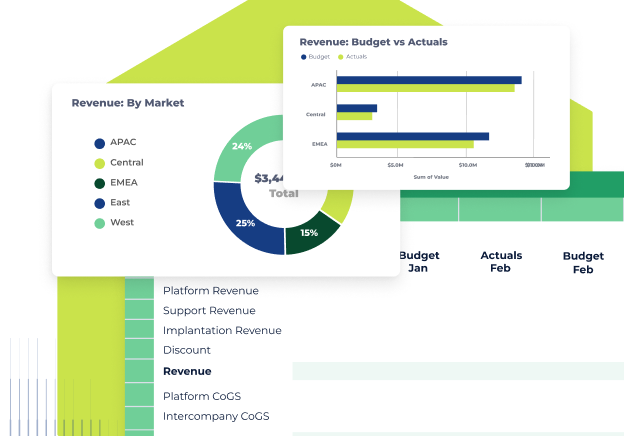Key takeaways
- Strategic finance isn’t achieved with technology upgrades alone; true transformation happens when people, processes, and technology are working in sync.
- People are the linchpin of every successful finance transformation, and cross-functional communication is a key element.
- Strategic finance relies on trusted data and flexible technology that empowers greater insights and better decisions, not just faster reporting.
What is finance transformation really?
To outsiders, "finance transformation" is often associated with simply implementing new software, but it's more than that.
At its core, finance transformation is about shifting the team's focus from reporting on what happened to influencing what happens next. It's a move away from being purely operational to becoming truly strategic.
This means spending less time manually cleaning data or chasing numbers and more time modeling scenarios, advising stakeholders, and helping the company make smarter decisions that move the business forward.
This isn’t just a matter of speed. Higher-value work requires the right foundation. While technology plays a role, it’s not a standalone solution. Real finance transformation happens when people, processes, and technology work together, supported by structural change, clear responsibilities, and a new way of operating.

Cube’s approach to finance transformation: People, process, and technology
If strategic finance is the goal, then aligning people, process, and technology is how you get there. When you get these three areas working together, that’s when true finance transformation happens.
Here’s a deeper look into why this is and what finance transformation looks like in practice.
People
At the end of the day, everything is a people problem, and everything is a people solution. But too often, that part of the transformation conversation gets overlooked.
Finance transformation starts by aligning people: making responsibilities clear, building trust, and fostering communication within the team and across the business. When everyone knows who owns what, how to work together, and how information flows, finance teams spend less time chasing data, fixing errors, and clarifying next steps. They’re free to focus on guiding decisions that move the business forward.
Let’s take data management for example. The most successful organizations assign data owners. Someone owns data governance, someone owns data cleansing, and so on.
Rather than treating these assignments as side tasks or simply throwing technology into the mix, hoping it effectively manages data on its own, these businesses treat data ownership as a core responsibility with clear accountability. This gives finance teams the reliable foundation they need to move faster, trust their data, and focus on strategic work.
Alignment also means knowing how to communicate beyond the finance team. Strategic finance leaders work closely with partners across the business, delivering insights in ways that are timely, relevant, and easy to act on. Creating a shared vocabulary, implementing collaborative planning processes, and developing KPIs that reflect how the business actually operates (not just what fits into a financial report) are all key to making these partnerships stronger and more effective.
Process
If people are the ones driving transformation, process is what keeps everything moving in the right direction. It’s how work gets done; how data flows, how reports are built, how plans are created, and how decisions are made. Without strong processes, even the best people and technology can’t deliver strategic results.
We’ll stick with the data management example to explain this one, too. While defining who owns the responsibility is critical, it’s equally important to have structured, repeatable systems so you can be sure that the data is accurate, clean, and consistently handled.
That includes things like auditing data integrity, setting up clear consolidation and governance workflows, and performing ongoing quality checks. (Read more about how to build this foundation in our guide, The future of strategic finance.)
Data management is of course just one part of the equation. Strong processes also shape how reporting happens, how planning cycles run, and how decisions move forward. The most effective teams establish clear workflows, set consistent cadences, document key steps, and make sure responsibilities are well-defined. When processes are standardized and repeatable, finance can operate more efficiently, communicate more clearly, and focus more energy on driving strategic outcomes.
Technology
The best technology solutions enhance how people work and make processes easy to optimize, without blanketly making finance teams give up their familiar and functional preferred ways of working, like using spreadsheets.
Spreadsheets are, after all, the lingua franca of finance. They’re flexible, powerful, and deeply embedded in how teams operate. But unfortunately, they weren’t built for collaboration or scale. And when it comes to telling the story behind the numbers, they’re lacking the structure, context, and visibility needed to guide clear, confident decisions.
That said, the key to flexibility isn’t replacing spreadsheets. It’s expanding what they can do.
The vision behind Cube is to give finance teams the best of both worlds: the freedom to stay in spreadsheets to benefit from their flexibility, and the power of an enterprise platform that supports strategic finance at every level.

From intention to execution
Transitioning from purely tactical to strategic finance takes more than upgraded tools or faster workflows. It requires true transformation, built on aligned people, strong processes, and technology that supports the way finance works.
Whether you're just getting started or looking to strengthen your foundation, our playbook, The Strategic Finance Hierarchy of Needs: evolving from data analyst to business partner, can help. It breaks down the layers of finance transformation, from data management to strategic influence, and gives you a roadmap to build a finance function that leads.
Dive into the playbook here.




.png)









.png)
-1.png)




.png)
.png)